The NHL’s inconsistency in the way they call their rules could have had major consequences had Matt Calvert’s injury gone differently.
The Colorado Avalanche won their Saturday night game against the Vancouver Canucks 5-4 in overtime, but all they wanted to talk about after the game was what happened to defenseman Matt Calvert.
During Saturday night’s game, Calvert took a shot off the back of his head while the Canucks were swarming in the offensive zone. Calvert was down on the ice in serious pain, and was bleeding from his head after the shot, and yet the officials on the ice did not call play dead with the defenseman writhing in pain. Instead, the Canucks pulled to within a goal on an empty net opportunity as Calvert remained on the ice from the shot he blocked a few long seconds prior.
The entire sequence is worth a watch, if not a hard one with the way Calvert tries — and fails — to get up from the ice before the Canucks scored.
This is honestly terrible pic.twitter.com/WUXN79tawo
— DNVR Avalanche (@DNVR_Avalanche) November 17, 2019
When asked after the game, fellow defenseman Erik Johnson ripped into the officials in an interview, calling the entire incident shameful.
“It’s a f*****g joke. You want to protect a guy? Guy’s got a family at home, he’s laying there bleeding out of his head and you don’t blow the whistle? It’s a complete joke. An absolute joke. They should be ashamed of themselves.”
Avalanche alternate captain Nathan MacKinnon was also critical of the play after the game, but called out the NHL‘s rule book instead of the officials on the ice.
“I can only imagine if that was LeBron James, his head was bleeding and they let the other team take a three-pointer to tie the game. I know it’s not the ref’s fault, it’s the league rule, but I think you need to look and see who’s laying on the ice.”
The NHL’s rules lay out protocol for injuries which happen in the midst of play, though it is often up to the discretion of the officials on the ice to call a play dead when there’s a serious injury.
"When a player is injured so that he cannot continue play or go to his bench, the play shall not be stopped until the injured player’s team has secured control of the puck. If the player’s team is in control of the puck at the time of injury, play shall be stopped immediately unless his team is in a scoring position.In the case where it is obvious that a player has sustained a serious injury, the Referee and/or Linesman may stop the play immediately."
The NHL putting the onus on the injured player’s team to recover the puck has been a long-standing rule in the league. Zach Werenski, Columbus Blue Jackets defenseman, took a puck to the face and was injured during a 2017 Stanley Cup playoff game against the Pittsburgh Penguins. Play continued while Werenski eventually made his way to the Blue Jackets’ bench, but the Penguins scored the tying goal in the critical sequence as Columbus never took control of the puck.
Werenski took to Twitter after the Calvert play to express his displeasure with the NHL’s ruling on injured players mid-game.
Has to be blown down. This play has to stop https://t.co/ig8WkmGT20
— Zach Werenski (@ZachWerenski) November 17, 2019
The NHL’s rulebook on mid-play injuries is quite flawed, especially given that it’s a judgement call that the on-ice officials need to make in the moment. Referees need to balance letting play go on as is during critical moments, while keeping the safety of the players in mind.
In Calvert’s case, there were at least two NHL officials keeping eyes on the zone as the play transpired. While no official was facing Calvert head on during the incident, as they’d have likely the better shot to see that the defenseman was bleeding, the length in which Calvert stayed down on the ice should have warranted calling the play dead well before the Canucks’ goal.
The NHL is extremely lucky Calvert wasn’t more severely injured than he was on the play. However, it seems like it’s only a matter of time before a player sustains a serious, yet possibly avoidable, injury if the NHL’s ruling stays as inconsistent as it is.
Judgement calls are hard in crucial situations, regular season or playoffs, and removing that aspect entirely should be the NHL’s priority in the next general manager meetings before things escalate further. Even adding just a bit more clarity to the rule for officials will go a long way in making sure this situation does not happen again. The players, and the sport of hockey, will be safer for it.
